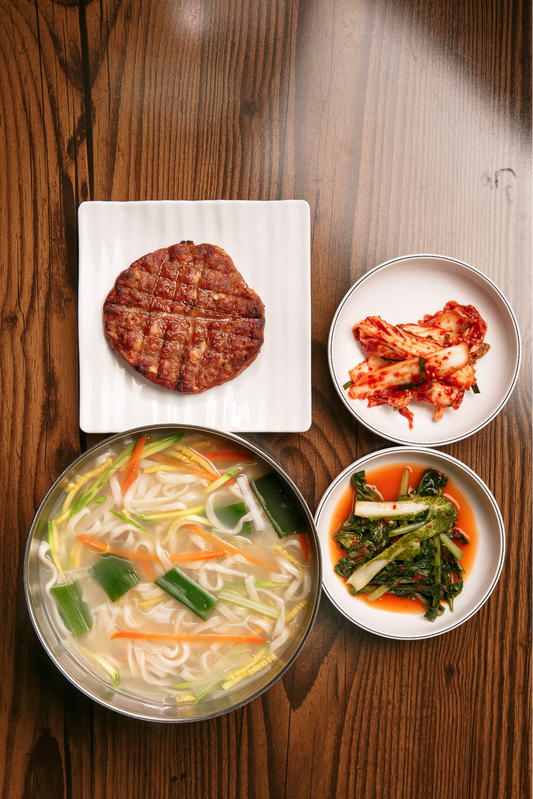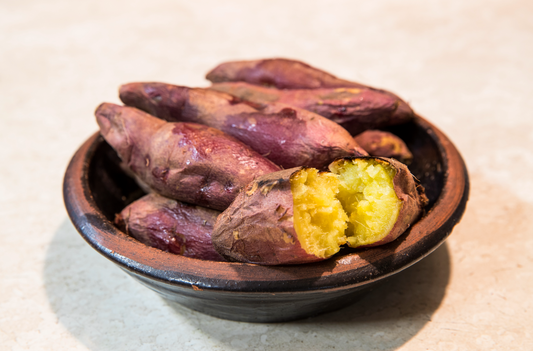Kimchi Pairing with Southeast Asian Cuisine: Hitsumabushi, Pad Thai, Tom Yum Goong, and Spring Rolls(Part2)

Tom Yum Goong: A Spicy-Sour Seafood Soup and Kimchi Combination
The Tom Yum Goong, a favorite Thai seafood soup, pairs perfectly with kimchi's strong, fermented taste. This mix highlights the tom yum goong kimchi pairing, where the soup's spicy-sour flavors meet the tang of kimchi. With ingredients like lemongrass, galangal, and kaffir lime leaves, this soup brings a flavorful seafood choice that fits well with kimchi with seafood soup.
Tom Yum Goong starts with a spicy broth. It's made tangy with lime juice and rich with Thai spices and herbs. Adding kimchi brings more depth, mixing spice and the deep taste of fermentation. This matches wonderfully with the fresh seafood, be it traditional shrimp or other sea delights. Kimchi highlights each taste in a special way.
Recipes often suggest simmering seafood with mushrooms and herbs, then adding a touch of creamy milk. This creates a smooth contrast to kimchi's crunch. By adjusting the kimchi amount, the kimchi with seafood soup can be customized for spice and taste, making the tom yum goong kimchi pairing flexible in both prep and serve.
This dish goes beyond classic recipes to celebrate new twists, inviting food lovers to try each flavorful bite. Whether alongside jasmine rice to absorb the broth or enjoyed alone, it offers a deeply satisfying meal experience.
The Taste and Characteristics of Tom Yum Goong
Tom Yum Goong is a key dish in Thai cuisine, loved for its strong spicy and sour flavors. This soup shines with the taste of lemongrass, galangal, and kaffir lime leaves. It brings the spirit of Southeast Asia. Added to this are shrimp, mushrooms, and tomatoes, making every bite a rich experience.
Description of the spicy, sour, and aromatic characteristics of Tom Yum Goong
What makes Tom Yum Goong special is its flavorful broth. It comes from carefully cooked chicken stock, shrimp shells, and heads. Chilies add heat, and lime juice adds a sharp sour kick. This mix of tastes is perfect. It also goes great with kimchi in spicy soups, where kimchi's fermented taste blends well with the soup’s zest.
For those who like intense tastes, the tom yum goong kimchi pairing is a treat. The spice from the kimchi highlights Tom Yum's heat, and its sourness matches the soup's citrus hints. Every bite is a new taste adventure. This isn’t just adding kimchi to the soup; it's a bold culinary mix that boosts the meal, especially for fans of Thai and Korean foods.
Tom Yum Goong stands out in the food world by mixing and showcasing different flavors. It combines the boldness of herbs with the sharpness of lime and chili. When paired with kimchi, it creates a deeper, very flavorful profile. This shows the depth of Asia's culinary tradition.

The Flavor Balance Between Tom Yum Goong and Kimchi
Exploring the vibrant world of southeast Asian cuisine, we find a unique tom yum goong kimchi pairing. This mix combines the spicy and sour tastes of Tom Yum with kimchi's strong, fermented flavors. It shows how traditional dishes can be versatile and have complex flavors. Both Thai and Korean foods are celebrated in this mix.
How the fermented notes of kimchi blend with the spicy and sour flavors of Tom Yum Goong
Tom Yum Goong is famous for its bold lemongrass aroma and sharp sourness. Kimchi adds a surprising depth that boosts the soup without hiding its key flavors. The fermented food in kimchi also brings good probiotics. These mix well with the soup's tangy taste. This makes the tom yum goong kimchi mix not just tasty but also good for health.
The fiery zest of Tom Yum Goong and kimchi's acidic bite create a unique flavor mix. This combination is special to southeast Asian cuisine. It invites eaters to try different textures and tastes, offering a stimulating and comforting experience. It shows how traditional dishes can grow with cross-cultural cooking while respecting their roots.
Tips and Recipe for Pairing Tom Yum Goong with Kimchi
Southeast Asian cuisine is full of chances for unique and tasty food pairings. A standout mix is the tom yum goong kimchi pairing. Whether you're an experienced chef or just like to cook at home, combining these two can make meals exciting. These kimchi pairing tips will show you how to mix the spicy taste of Tom Yum Goong with the sharp, tangy flavor of kimchi.
Best ways to serve kimchi alongside or in Tom Yum Goong for added depth
For newcomers, try kimchi on the side of Tom Yum Goong. This way, everyone can control how much kimchi they want, making sure its strong taste doesn't overshadow the soup's light seafood and herbal flavors.
If you're up for a challenge, mix kimchi right into the Tom Yum Goong. Chop the kimchi fine and stir it into the broth near the end. This adds a mild complexity and an extra layer of texture without taking over the other tastes.
Choose top-notch kimchi, like those from vegan brands Bibigo or Wang, to keep the dish open to everyone without losing the key flavors for a perfect tom yum goong kimchi pairing.
While trying these kimchi pairing tips, tweak the kimchi amount based on your soup's taste. Aim for a balance that delights the taste buds.
The real fun in these pairings is finding the right balance and daring to mix things up. Kimchi can greatly enhance Tom Yum Goong, whether added in or served as a side, offering a refreshing twist to your dishes.

Vietnamese Spring Rolls: Fresh, Crisp Rolls Paired with Kimchi
Vietnamese spring rolls and kimchi are becoming a top pick for Asian fusion lovers. These spring rolls, known for their crispness and fresh veggies, pair well with kimchi with fresh vegetable dishes. The spice from kimchi adds a bold touch to the spring rolls' mild flavors.
This mix shows how food traditions are blending into new dishes. Vietnamese spring rolls often have shrimp, rice noodles, and herbs. Adding kimchi brings heat, umami, and complexity.
The mix of these foods started with wollamssam—a Korean-style Vietnamese roll. A famous chef posted the recipe online, and it took off. Now, many are trying these recipes and changing how Vietnamese spring rolls are seen.
Vietnamese spring rolls and kimchi are both healthy. The spring rolls have fresh veggies and proteins, kimchi is good for your gut. They're tasty and healthy.
Their popularity shows how classic foods can change, giving eaters new flavors. It makes food lovers try different tastes and brings cultures together through food.
The Fresh Flavors of Vietnamese Spring Rolls
Vietnamese spring rolls capture the spirit of Southeast Asia. They mix fresh, crisp ingredients in soft rice paper. This dish blends traditional cooking with bold kimchi flavors. Such a combo creates a fragrant, tasty medley.
Overview of the fresh herbs, vegetables, and proteins used in Vietnamese Spring Rolls
Vietnamese spring rolls are packed with fresh herbs like cilantro and mint. They also have crisp veggies such as cucumbers and carrots, with shrimp or pork adding a juicy bite. These fresh elements balance the richer sauces and the spicy kick from kimchi, a well-loved ferment.
Adding kimchi introduces a burst of flavor. It could be inside the rolls or on the side for dipping. Kimchi's bold, spicy taste elevates the dish, making it more enjoyable.
Kimchi and Vietnamese spring rolls together promote a fruitful dialogue between the crisp, refreshing qualities of the rolls and the intense, complex flavors characteristic of fermented foods.
The ingredients in Vietnamese spring rolls can vary. This makes them great for all kinds of eaters. You can have traditional shrimp and pork or go for tofu and mushrooms if you're vegetarian or vegan. This versatility is a sign of how inclusive Southeast Asian food is.
Vietnamese spring rolls are a key dish in Southeast Asia's diverse cuisine. They show how fresh and preserved flavors can come together beautifully. This dish is a celebration of freshness and the tangy taste of kimchi.

Kimchi and Vietnamese Spring Rolls Flavor Combination
The mix of kimchi's spiciness with the mild taste of Vietnamese spring rolls makes eating fun. By using kimchi pairing tips, cooks can make these rolls more exciting. They add different textures and flavors that amaze the taste buds.
How kimchi’s spiciness adds complexity to the fresh, light flavors of the spring rolls
Vietnamese spring rolls are known for their crisp veggies and herbs wrapped in soft rice paper. Adding the strong taste of kimchi, like Eden Foods Organic Kimchi Sauerkraut, changes these rolls into something special. The kimchi's tartness and warmth mix with the mild cucumber and carrot, creating unforgettable flavors.
To make this combo even better, add almond butter sauce mixed with lime juice and chili garlic. This sauce brings out the flavors more. Mixing Vietnamese spring rolls and kimchi adds fun complexity to the dish. It's perfect for summer parties or a tasty, healthy snack.
Enrich your Vietnamese spring rolls with the dynamic flavor of kimchi and watch the ordinary become extraordinary.
These pairings are not just tasty but also fit various diets as they are vegan and gluten-free. It's no wonder this mix is becoming popular. It combines Korean and Vietnamese cuisines into a nutritious, delicious meal.
Tips and Recipe for Pairing Vietnamese Spring Rolls with Kimchi
If you love the fresh taste of Vietnamese spring rolls and the tangy kick of kimchi, combining them is exciting. A guide for pairing suggests adding chopped kimchi into the rolls before wrapping. It also recommends using kimchi in the dipping sauce. This twist on traditional Vietnamese cuisine with fermented kimchi spices up the dish. It also boosts gut health and fights inflammation.
Suggested ways to incorporate kimchi into the rolls or as a dipping side
Mixing Vietnamese spring rolls with kimchi balances taste and health. Try a recipe that includes shredded red cabbage, carrot, and kale with kimchi. This mix offers many nutrients and a complex flavor. Vegetables with the spicy kimchi create an irresistible meal. For sauces, get creative. Make an almond sauce with almond butter, coconut aminos, ginger, and jalapeño. This sauce adds a creamy, spicy flavor to the rolls.
Enjoy Vietnamese spring rolls with kimchi soon after making them for the best freshness. If you need to save them, keep them cold and wrapped well. Feel free to customize your spring rolls. Add chicken or tofu for protein, vary the vegetables, or adjust the spices as you like. These spring rolls are great for a light lunch or a fun appetizer. They blend tradition and creativity, making each bite a taste of cultural harmony and personal flavor.
FAQ
What is the best way to pair kimchi with Hitsumabushi?
Try adding finely chopped kimchi on top. Or, serve it as a side. You can also drizzle kimchi juice over for a milder taste.
This adds a spicy kick and a fresh tang that goes well with the dish's umami.
Can kimchi be added to Pad Thai?
Yes, kimchi works in Pad Thai. Add it while stir-frying or on the side. Its sharpness offers a refreshing contrast to Pad Thai's flavors.
How does kimchi complement the flavors of Tom Yum Goong?
Kimchi adds complexity to Tom Yum Goong. Its fermented taste layers with the soup's spice and sourness.
You can serve it on the side or chop it into the soup.
Is kimchi a good match for Vietnamese spring rolls?
Kimchi's spice pairs well with the lightness of Vietnamese spring rolls. It can go inside the rolls or in a unique dipping sauce.
This mix creates a delightful blend of Korean and Vietnamese tastes.
Are there any general tips for pairing kimchi with Southeast Asian dishes?
When adding kimchi to Southeast Asian dishes, aim for balance. It should elevate but not dominate the meal.
Using it as a condiment or side lets everyone adjust to their liking.











